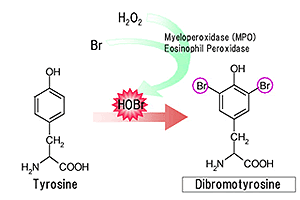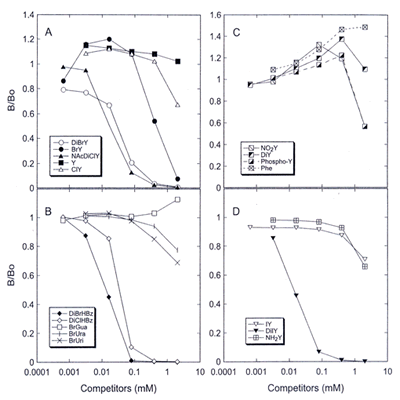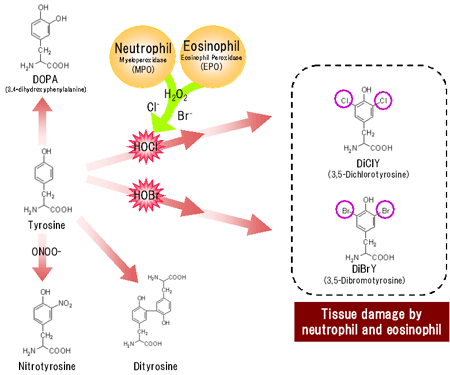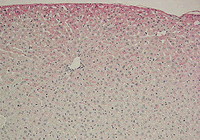 |
Oxidative Stress
Rev.081022 |
Anti dibromotyrosine (DiBrY)
monoclonal antibody |
|
| [ A novel biomarker for protein oxidation ] |
 |
Neutrophils and eosinophils play an important role in the defence system against microbial infection.
Myeloperoxidase (MPO) and eosinophil peroxidase (EPO) are known to catalyze formation of hypochlorous acid (HOCl) and
hypobromous acid (HOBr). These reactive intermediates may react with proteins, lipids and nucleotides,
and it has been reported to form tyrosine halogenation such as dibromotyrosine (DiBrY).
DiBrY is a Br-modified tyrosine at 3- and 5- position, which is one of the major oxidative products derived from
neutrophil myeloperoxidase.
|
|
| [ Specifications ] |
| Antigen: |
3,5-dibromotyrosine conjugated KLH(keyhole limpet hemocyanin). |
| Form: |
Lyophilized power. Reconstitute by 200 µL of distilled water. 100 µg/mL of IgG. |
| Subclass: |
Mouse IgG1(kappa), clone 3A5. Protein A purified. |
| Specificity: |
This antibody can react with dibromotyrosine (DiBrY), N-acetylated dichloro tyrosine (NAcDiClY),
diiodo tyrosine (DiIY), N-bromosuccinimide-treated BSA, HOCl-treated BSA and dibromo-tyrosone conjugated BSA
(halogene-modified tyrosine at both 3- and 5-position).
Cross reactivity to following analogues have been tested:
dityrosine-conjugated BSA, peroxynitrite-treated BSA, tyrosine (Y), chrolotyrosine(ClY), 3-3’-dityrosine (DiY),
3-aminotyrosine (NH2Y), 3-nitrotyrosine (NO2Y), phenylalanine (Phe), o-phosphotyrosine, 3,4-dihydroxyphenylacetic acid (DOPA)
and 2-hydroxy-4-phenylacetic acid. Weakly react with Bromotyrosine (BrY). |
| Application: |
Immunohistochemistry, western blotting and ELISA. |
| Storage: |
Less than -20°C |
|
| [ References ] |
| 1) |
Y Kato, Y Kawai, H Morinaga, H Kondo, N Dozaki, N Kitamoto and T Osawa.
Immunogenicity of a brominated protein and successive establishment of a monoclonal antibody to dihalogenated tyrosine.
Free Rad Biol Med, 38, p24-31 (2005) |
| 2) |
Wu W, Chen Y, d'Avignon A, Hazen SL.
3-Bromotyrosine and 3,5-dibromotyrosine are major products of protein oxidation by eosinophil peroxidase:
potential markers for eosinophil-dependent tissue injury in vivo. Biochemistry.38(12):3538-48 (1999) |
|
| Product name |
Code |
Content |
| Anti dibromotyrosine monoclonal antibody |
MBY-020P |
20 µg IgG |
|
|
| FOR RESEARCH USE ONLY. Not for diagnostic, medical or other use. |
| [ Specific to dihalogenated tyrosine at 3- and 5-position] |
|
Monoclonal antibody clone 3A5 have been established by Dr. Toshihiko Osawa (Nagoya Univ.) and Dr. Yoji Kato (Univ. Hyogo).
This antibody is specific for 3,5-Dibrominated tyrosine and other di-halogenated tyrosine at 3- and 5- position.
Suitable for immunohistochemical analysys of oxidative stress.
|
 |
|
 |
| [ Oxidative modification of tyrosine ] |
 |
Tyrosine is one of the main targets of protein oxidation, and it have been reported form
nitrotyrosine, dityrosine and halogenated tyrosines depending on the type of free radicals.
For example, hypochlorous acid (HOCl) and hypobromous acid (HOBr) are derived from neutrophil myeloperoxidase (MPO) and
eosinophil peroxidase (EPO), and known to form dihalogenated tyrosines such as DiBrY, DiClY and DiIY.
It is expected that DiBrY may be a novel biomarker for tissue damage which is related to inflammatory and allergic disorders. |
|
| FOR RESEARCH USE ONLY. Not for diagnostic, medical or other use. |
|



